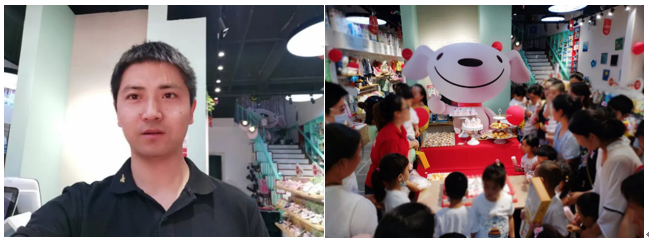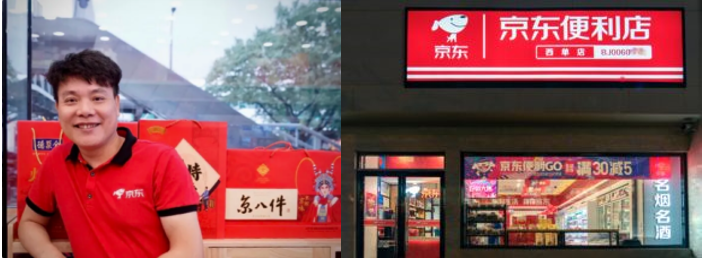Dec 10, 2020|
In-Depth Report: JD New Markets – Aiming at Lower-Tier Regions
by Yuchuan Wang
The omnichannel-based JD New Markets business has become the offline home court of JD.com. JD New Markets is a B2B2C model. Committed to serving China’s over 6.8 million offline mom-and-pop stores, the business leverages JD.com’s expertise in e-commerce, logistics and technology to connect the supply from brands to nationwide offline stores.
Launched in December 2015, through its “Retailers’ Helper” purchasing app, smart store management system and the omnichannel mini program JD Convenience Go, JD New Markets is able to provide small-and-medium sized stores with digital solutions to attract both online and offline traffic and increase shop owners’ earnings.
Supplying nationwide mom-and-pop stores
At a mom-and-pop store in some rural areas in China, it is not uncommon to find copycat versions of large brands.
A popular beverage (left) and its copycat (right)
In the past, shop owners either purchased goods from wholesale markets or salesmen at various distributors for different products and brands. In addition to copycats, price differentiation was also an issue.
“Retailers’ Helper” (zgb.jd.com) was launched by JD New Markets in 2016 to combat these challenges. The one-stop B2B purchasing platform designed specifically for mom-and-pop stores enables shop owners to order authentic and quality products from JD and brands through the app. Leveraging JD’s resources, including suppliers, goods and ecosystem partners, Retailers’ Helper provides an integrated full-category purchasing experience. It also handles the delivery to stores.
There are already over 8,500 brands and over one million users on the platform, among which 70% come from third-tier or lower cities.
In 2018, JD New Markets further improved the purchasing ecosystem by launching the “Joint Warehouse” program, aiming to add brands’ authorized distributors and wholesalers’ local stock and delivery capability to provide timely delivery of goods to mom-and-pop stores, in addition to JD’s own warehousing and distribution network. Under this model, products with a high turnover are prioritized by joint warehouses while other products can be sourced and shipped from JD’s centralized warehouses, but fulfilled by joint warehouses.
Goods inside joint warehouses of partners
As of now, JD New Markets has a network of more than 4,000 joint warehouses covering over 300 cities and 1,800 counties, with 64% of them in third-tier or lower cities. The program has greatly enhanced JD New Markets’ product offerings and coverage, improving cost, efficiency and experience for the stores.
Multiple store formats, omnichannel fulfillment
By offering access to JD’s brand collateral (i.e. logo), and providing guidance in store designs, management, service standards, procurement and logistics, traditional stores have become “JD Convenience Stores”, “JD Maternal and Baby Shops”, “JD Wine Shops” and more.
Qumarlêb is a county in central-south of Qinghai province, in the northwest of China with an elevation of around 4,200 meters. The high altitude means cold weather and difficulty accessing supplies. With the help of JD New Markets, resident Di Gao, opened a JD Convenience Store in the county. With access to JD’s inventory resources, local residents can buy a much wider selection of products than before and at transparent prices. In addition, leveraging JD’s smart store management system, Gao knows what products are most popular and when to sell them.
Value-added services such as printing, parcel collection, and housekeeping services are also provided in convenience stores such as Gao’s. This helps a store gain extra traffic.
Di Gao (second from left) and her friends
At JD Wine Shop and JD Material and Baby Shop locations, consumers can enjoy the quality service they get online with JD because goods sourcing, pricing and marketing are all strictly controlled. For example, each bottle of wine has an anti-counterfeit tracing code attached. Customers can scan the code to view the entire supply chain process.
“The COVID-19 pandemic led to the closure of many offline stores earlier this year. But, thanks to JD, our customers increased a lot,” said Pai Peng, a JD Maternal and Baby Shop owner in Xi’an, Shaanxi province.
JD’s supply chain innovation program which connects Peng’s store with JD’s e-commerce traffic helped him thrive at a time when many store operators struggled.
Instead of sourcing online orders from warehouses, and then sending them through distribution centers and delivery stations prior to delivery to the customer, JD leverages offline retail outlets like Peng’s store and sources inventory from there instead.
In addition, the JD Convenience Go mini program on WeChat enables neighborhood customers to order from a brick and mortar store directly and have products delivered by crowd-sourced couriers.
“My shop opened in September in 2019, but we amazingly reached break-even as soon as in February in 2020,” said Peng. “In October, revenue from our offline channel was RMB 120,000 yuan while it was RMB 150,000 yuan through the online channels. I’ve seen accelerated profitability.”
Peng is quite confident in his business, “I hope to open three-to-five more JD Maternal and Baby Shops in the future.”
Pai Peng (left) and his JD Maternal and Baby Shop (right)
Technology enables deep understanding of customers
Technology plays an important role in retail, especially in equipping traditional mom-and-pop store owners.
Data from brands to stores and to end customers’ shopping behaviors are aggregated on JD New Market’s smart store management platform, together with the supplementary data analysis from the online FMCG (fast-moving consumer goods) business on the JD.com platform, which has over 400 million Chinese consumers.
“What JD provides to me is not only a store operation plan, but also a business plan based on customer profiles,” said Jianxing Fang, who runs two JD Convenience Stores in Beijing.
JD’s team was involved in the entire set up process for both stores, from location evaluation based on big data, decoration and layout, product selection and the implementation of new technologies such as smart store management, as well as an automated checkout system.
Even though first store is only dozens of square meters, maximum daily sales have reached nearly RMB 40,000 yuan.
Jianxing Fang and his convenience store in Xidan district, Beijing
Retailers’ Helper also gives shop owners a “smart” purchasing experience. By analyzing store location, its neighborhood consumption and the store’s sales, the platform is able to recommend different product portfolios to different shop owners to attract more local traffic from target consumers and increase sales. For example, a 100 ml bottle of shampoo (the maximum amount allowed on most flights) will be found at stores in airports or train stations, rather than a residential community store.
With the help of JD New Markets, millions of shop owners are gaining access to authentic products, services and technology, enabling them to sell at better price by knowing better of customers. And in turn, JD New Markets has been helping JD.com expand its coverage offline especially in lower-tier cities and reach more consumers.
“The value of B2B should not stop at the commodity circulation level. [It should also cover] omnichannel supply and empower brands to stores to end consumers,” said Arthur Zheng, head of JD New Markets. “We will continue to optimize the supply of goods and services provided by JD New Markets, to jointly create better stores and provide consumers with the best possible shopping experience.”






 This Harbin tourism boom has also spurred a surge in sales of winter apparel. JD.com’s data indicates a rapid growth in the sales of warm clothing items such as down jackets, snow boots, and thermal underwear between January 1st and 7th. The sales growth is especially pronounced in southern provinces and cities such as Jiangsu, Zhejiang, Guangdong, Sichuan, and Shanghai. Notably, tall snow boots registered a 206% year-on-year increase in transactions, while padded cotton caps and thickened long down jackets soared by 158% and 134%, respectively. Beyond clothing, travel gear has also seen a considerable uptick, with a 98% year-on-year growth in transactions for large suitcases and travel backpacks in these southern regions.
This Harbin tourism boom has also spurred a surge in sales of winter apparel. JD.com’s data indicates a rapid growth in the sales of warm clothing items such as down jackets, snow boots, and thermal underwear between January 1st and 7th. The sales growth is especially pronounced in southern provinces and cities such as Jiangsu, Zhejiang, Guangdong, Sichuan, and Shanghai. Notably, tall snow boots registered a 206% year-on-year increase in transactions, while padded cotton caps and thickened long down jackets soared by 158% and 134%, respectively. Beyond clothing, travel gear has also seen a considerable uptick, with a 98% year-on-year growth in transactions for large suitcases and travel backpacks in these southern regions.
 In-Depth Report: JD Helps China’s Elderly Embrace New Tech Frontiers
In-Depth Report: JD Helps China’s Elderly Embrace New Tech Frontiers



